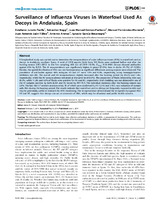Mostrar el registro sencillo del ítem
Surveillance of Influenza Viruses in Waterfowl Used As Decoys in Andalusia, Spain
| dc.contributor.author | Jurado Tarifa, Estefanía | |
| dc.contributor.author | Napp, Sebastián | |
| dc.contributor.author | Gómez-Pacheco, Juan M. | |
| dc.contributor.author | Fernández-Morente, Manuel | |
| dc.contributor.author | Arenas-Casas, Antonio | |
| dc.contributor.author | García-Bocanegra, Ignacio | |
| dc.contributor.author | Jaén-Téllez, Juan Antonio | |
| dc.date.accessioned | 2017-11-30T12:20:04Z | |
| dc.date.available | 2017-11-30T12:20:04Z | |
| dc.date.issued | 2014 | |
| dc.identifier.uri | http://hdl.handle.net/10396/15600 | |
| dc.description.abstract | A longitudinal study was carried out to determine the seroprevalence of avian influenza viruses (AIVs) in waterfowl used as decoys in Andalusia, southern Spain. A total of 2319 aquatic birds from 193 flocks were analyzed before and after the hunting season 2011–2012. In the first sampling, 403 out of 2319 (18.0%, CI95%: 15.8–19.0) decoys showed antibodies against AIVs by ELISA. The AI seroprevalence was significantly higher in geese (21.0%) than in ducks (11.7%) (P,0.001). Besides, the spatial distribution of AIVs was not homogeneous as significant differences among regions were observed. The prevalence of antibodies against AIVs subtypes H5 and H7 were 1.1% and 0.3%, respectively, using hemagglutination inhibition test (HI). The overall and H5 seroprevalences slightly increased after the hunting period (to 19.2% and 1.4%, respectively), while the H7 seroprevalence remained at the same level (0.3%). The proportion of flocks infected by AIVs was 65.3%, while 11.2% and 4.9% of flocks were positive for H5 and H7, respectively. Viral shedding was not detected in any of the 47 samples positive by both ELISA and HI, tested by RRT-PCR. The individual incidence after the hunting season was 3.4%. The fact that 57 animals seroconverted, 15 of which were confirmed by HI (12 H5 and 3 H7), was indication of contact with AIVs during the hunting period. The results indicate that waterfowl used as decoys are frequently exposed to AIVs and may be potentially useful as sentinels for AIVs monitoring. The seroprevalence detected and the seropositivity against AIVs H5 and H7, suggest that decoys can act as reservoirs of AIVs, which may be of animal and public health concern | es_ES |
| dc.format.mimetype | application/pdf | es_ES |
| dc.language.iso | eng | es_ES |
| dc.publisher | Public Library of Science | es_ES |
| dc.rights | https://creativecommons.org/licenses/by-nc-nd/4.0/ | es_ES |
| dc.source | PLoS ONE 9(6): e98890 (2014) | es_ES |
| dc.subject | Avian influenza viruses | es_ES |
| dc.subject | AIVs | es_ES |
| dc.subject | Andalusia | es_ES |
| dc.subject | AI seroprevalence | es_ES |
| dc.title | Surveillance of Influenza Viruses in Waterfowl Used As Decoys in Andalusia, Spain | es_ES |
| dc.type | info:eu-repo/semantics/article | es_ES |
| dc.relation.publisherversion | http://dx.doi.org/10.1371/journal.pone.0098890 | es_ES |
| dc.rights.accessRights | info:eu-repo/semantics/openAccess | es_ES |

